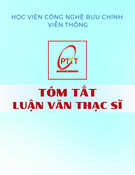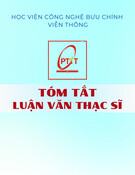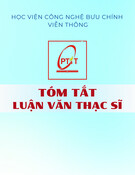
MINISTRY OF EDUCATION VIETNAM ACADEMY OF SCIENCE
AND TRAINING AND TECHNOLOGY
GRADUATE UNIVERSITY OF SCIENCE AND TECHNOLOGY
———————————-
DO THI HONG HAI
EXCITONIC CONDENSATION
IN SEMIMETAL – SEMICONDUCTOR TRANSITION SYSTEMS
Major: Theoretical Physics and Maths Physics
Code: 9.44.01.03
SUMMARY OF PHYCICS DOCTORAL THESIS
Hanoi – 2020

The thesis has been completed at Graduate University of Science and Technology, Vietnam
Academy of Science and Technology.
Supervisor 1: Assoc.Prof.Dr. Phan Van Nham
Supervisor 2: Assoc.Prof.Dr. Tran Minh Tien
Reviewer 1:
Reviewer 2:
Reviewer 3:
The thesis will be defended to the thesis committee for the Doctoral Degree, at Graduate
University of Science and Technology – Vietnam Academy of Science and Technology, on
Date.....Month.....Year 2020.
Hardcopy of the thesis can be found at:
- Library of Graduate University of Science and Technology
- National Library of Vietnam.

INTRODUCTION
1. Motivation
The condensate state of the electron-hole pairs (or excitons) has recently become one
of the attractive research objects. Electrons and holes have semi-integer spin, so the excitons
act as bosons and if the temperature is sufficiently low, these excitons can condense in a new
macroscopic phase-coherent quantum state called an excitonic insulator – EI.
Although first theoretical of the excitonic condensation state in the semimetal (SM) and
semiconductor (SC) systems was proposed over a half of century ago but the experimental
realization has proven to be quite challenging. In recent years, materials promising to observe
EI state have been investigated, such as mixed-valent rare-earth chalcogenide TmSe0.45Te0.55,
transition-metal dichalcogenide 1T-TiSe2, semiconductor Ta2NiSe5, layer double graphene,...
which have increased the studies of the excitonic condensation state both the theoretical side
and the experimental side.
On the theoretical side, the excitonic condensation state is often studied through investi-
gating the extended Falicov-Kimball model by many different methods such as the mean-field
(MF) theory and T−matrices, an SO(2)-invariant slave-boson approach, the approximate vari-
ational cluster method, projector-based renormalization (PR) method, . . . The authors have
shown the existence of the excitonic condensation state near the SM – SC transition. However,
in the above studies, investigating the EI state was mainly based on purely electronic charac-
teristics with the attractive Coulomb interaction between electrons and holes. Therefore, the
coupling of electrons or excitons to the phonon was completely neglected.
Besides, when studying the EI state of the semimetallic 1T-TiSe2by applying BCS su-
perconductivity theory to the electron – hole pairs, C. Monney and co-workers have con-
firmed that the condensation of excitons affects the lattice through an electron – phonon in-
teraction at low temperature. Recently, when studying the condensation state of excitons in
transition metal Ta2NiSe5by using the band structure calculation and MF analysis for the
three-chain Hubbard model phonon degrees of freedom, T. Kaneko has confirmed the origin
of the orthorhombic-to-monoclinic phase transition. Without any doubt, lattice distortion or
phonon effects are significantly important in this kind of material, particularly, in establishing
the excitonic condensation state. Based on this, B. Zenker and co-workers studied the EI state
in a two-band model by using the Kadanoff-Baym approach and mean-field Green function,
or in the EFK model concluding one valence and three conduction bands by using the MF
approximation and the frozen-phonon approximation when considering both the Coulomb in-
teraction between the electron – hole and the electron – phonon interaction. The authors have
affirmed that that both the Coulomb interaction and the electron – phonon coupling act to-
gether in binding the electron – hole pairs and establishing the excitonic condensation state.
1

However, B. Zenker has studied only for the ground state, i.e., at zero temperature.
Recently, in Vietnam, investigating EI state in EFK model was also studied by Phan Van
Nham and co-workers in a completely quantum viewpoint. By PR method, lattice distortion
causing EI state is also intensively studied on the theoretical side, however, only for the ground
state. In general, as a kind of superfluidity, the EI state possibly occurs at finite temperature,
and at high temperature, it might be deformed by thermal fluctuations. Clearly, the study of
the excitonic condensation in Vietnam need to be further promoted. In order to contribute to
the development of new research in Vietnam on the excitonic condensation, in the present
thesis, we focus on the problem of “Excitonic condensation in semimetal – semiconductor
transition systems” to investigate the nature of the excitonic condensation state in these mod-
els by using MF theory. Electronic correlation in the systems is described by the two-band
model including electron – phonon interaction and the extended Falicov-Kimball model in-
volving electron – phonon interaction. Under the influence of Coulomb interaction between
electron – hole, the electron – phonon interaction as well as the influence of the temperature
or the extenal pressure, the nature of the excitonic condensation state especially the BCS –
BEC crossover or competition with the CDW state in the system is clarified.
2. Purpose
Investigating the excitonic condensation phase transition in SM – SC transition systems.
In detail:
•Developing mean-field theory for a 2D two-band model including electron – phonon
interaction and the extended Falicov-Kimball model involving electron/hole – phonon
interaction.
•Studying the properties of electronic systems in EI state through investigating the above
models. Then, we compare the nature of each condensation state on both sides of the
BCS – BEC crossover or the competition with the CDW state.
3. Main contents
The content of the thesis includes: Introduction of exciton and excitonic condensation
states; Mean-field theory and application; The results of the study about excitonic condensa-
tion state in the two-band models when considering effects of phonon, the Coulomb interac-
tion, the extenal pressure and the temperature by mean-field theory. The main results of the
thesis are presented in chapters 3 and 4.
2

CHAPTER 1. EXCITON AND EXCITONIC CONDENSATION STATES
1.1. The concept of excitons
1.1.1. What is an exciton?
An exciton is a bound state of an electron in conduction band and a hole in valence
band which are attracted to each other by the Coulomb interaction. Depending on the role
of Coulomb attraction in different systems that the size of the excitons can vary from a few
angstroms to a few hundred angstroms.
1.1.2. The exciton creation and annihilation operators
Considering a two-band model with f†
pand c†
pare hole creation operators in valence
band and electron creation operators in conduction band with momentum p, respectively. We
can write exciton creation operators relating with electron and hole creation operators
a†
k,n =1
√VX
p,p′
δk,p+p′ϕn(q)c†
pf†
p′.(1.17)
From the anticommuting properties of creation, annihilation operators of electrons and
holes, the excitons atc as bosons with the creation and annihilation operators satisfying the
commutation relations.
1.2. BEC and excitonic condensation states
Bose-Einstein condensed (BEC) is the condensation state of bosons at low tempera-
ture with a large number of particles in the same quantum state. Because the excitons are
pseudo-bosons, they condensate in the BEC state in the low density limit as the independent
atoms and the Fermi surface does not play a role in the formation of electron – hole pairs.
In contrast, the excitons condensate in the BCS state in the high density limit similar to the
superconducting state described by the BCS theory. Studying the BCS – BEC crossover of
excitons is considered an interesting problem when examining excitonic condensation state.
As the temperature increases, condensased states are broken by temperature fluctuations. The
system transfers to a free exciton gas state from the BEC-type, while the BCS-type transfers
to an plasma of electrons and holes.
1.3. Achievements of excitonic condensation research
1.3.1. Theoretical research
By applying from the MF approximation to the more complex methods for the EFK
model, the existence of EI state in both BCS-type and BEC-type near the SM – SC transition
has been confirmed. Then the BCS – BEC crossover of EI phase is also considered.
When studying the EI state of the SM structure 1T-TiSe2, C. Monney and co-workers
confirmed the existence of the EI state at low temperature and the electron-hole pairing may
lead to the Ti ionic displacement. In other words, the exciton causes a lattice displacement
3














![Đề án Thạc sĩ: Tổ chức hoạt động văn hóa cho sinh viên Trường Cao đẳng Du lịch Hà Nội [Chuẩn nhất]](https://cdn.tailieu.vn/images/document/thumbnail/2025/20251202/kimphuong1001/135x160/91661764646353.jpg)











